Butler's Lodge
Houses within 10km of this house
Displaying 32 houses.
Houses within 10km of Butler's Lodge
Displaying 32 houses.
| House name | Description | |
|---|---|---|
| Lisheen Castle | Lisheen Castle was the home of a branch of the Lloyd family from at least 1837. Altered and extended by John Lloyd, it was valued at £42+ at the time of Griffith's Valuation and held by John Lloyd in fee. The Lloyd family continued to live at the Castle until the 1880s though Slater refers to it as a seat of Mrs.Lloyd as late as 1894. It was subsequently leased and then in 1918 sold to William Bray O'Brien of Ardfort House, Thurles. When the castle was burnt in 1921 it was the property of O'Brien's daughter and son-i- law Camilla and John Francis O'Meara. In 1994 the ruins were purchased by Joan and Michael Everard who have restored the building which now offers luxury castle accommodation. see http://www.lisheencastle.com/ |
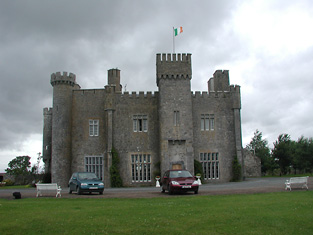
|
| Summerhill | Richard Bourke was resident at Summer-hill, Burris-o-leagh, in 1814 but by 1837 J.H. Harden was the proprietor. At the time of Griffith's Valuation Charles F. Harden held the house, valued at £11, from John H. Harden. Buildings are still extant at this site. | |
| Dovea | A house built circa 1830s and occupied by J. Trant in 1837. The Ordnance Survey Name Books describe it as "a handsome residence" in 1840, though it mentions Mr. Ellis as the actual resident. John Trant held the property in fee at the time of Griffith's Valuation when the buildings were valued at £79+. This house was still in the possession of the Trant family at the beginning of the 1940s but by the time of the Irish Tourist Association Survey had been bought by Ballduff Co Operative, Thurles, who had plans to turn it into a model farm. It is now the headquarters of Dovea Genetics, see http://www.dovea.ie/html/history_of_dovea.html. |

|
| Fishmoyne | A junior branch of the Carden family lived at Fishmoyne from the mid 18th century. Bence Jones writes that the house was built in the 19th century replacing the original house which was destroyed by fire. Wilson, writing in 1786, notes Fishmoynne as the seat of Mr. Carden. A Mrs Butler was resident in 1814 and R. Minchin Carden in 1837. Richard Carden held the property in fee in the early 1850s when it was valued at £56.17 shillings. This house remained the property of the Carden family until 1955. The Irish Tourish Association survey records the house as "idle and locked up" in the early 1940s. Fishmoyne is no longer extant. | |
| Bellwood | The Reverend Archer was living at Greenwood in 1814. Bellwood is the name given to the house marked in this townland on the first edition Ordnance Survey map. Henry Lysaght was the occupier at the time of Griffith's Valuation holding the house valued at £11+ from Sir John C. Carden. This building is still a residence. |
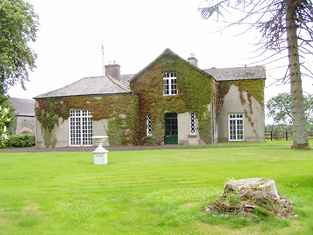
|
| Oldtown | The home of the Bennett family in the 19th century, occupied by Theophilus Bennett in 1814 and by John Bennett in the early 1850s. The property was held from the Cardens and the buildings were valued at £19+ in the mid 19th century. This house was demolished by the early 20th century. | |
| Templemore Abbey/The Priory | In 1837 Lewis refers to the Castle at Templemore being the residence of the Carden family "up to about a century ago" when it was accidentially burnt by fire. He states that more recently the Carden family had lived at the Priory, a house marked on the first edition Ordnance Survey map and valued at £96+ at the time of Griffith's Valuation. This house was rebuilt in the 1860s and was burnt in the early 1920s. The stableyard is still extant. In 1894 Slater had referred to Templemore Abbey as the seat of Sir John C. Carden. |
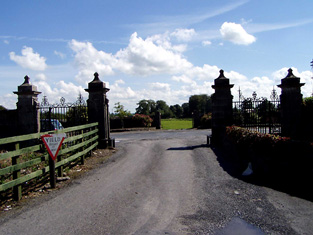
|
| Woodville | The residence of the Webb family in the 19th century. The house was valued at £49+ in the early 1850s, occupied by Captain Daniel James Webb and held from Sir John C. Carden. Still a fine residence just south of Templemore. |
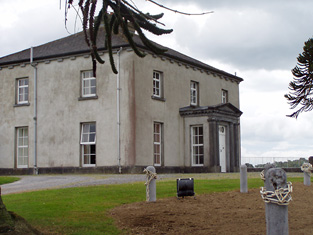
|
| Eastwood | Lewis records Thomas Bennett as the proprietor of Eastwood. James Mason held Eastwood House and 209 acres from Thomas Bennett at the time of Griffith's Valuation. The buildings were valued at £22+. Buildings are still located at this site. | |
| Fortfield House | Located close to Lisheen Castle, occupied by H. Lloyd in 1837 and by William Butler at the time of Griffith's Valuation. William Butler was married to Catherine Lloyd and held Fortfield, valued at £19+, from his father in law John Lloyd. Home of the Everard family since the mid 19th century. see http://www.lisheencastle.com/?page_id=2 | |
| Brownstown | A house valued at £22 in the early 1850s occupied by Samuel Cooke and held from Captain Gould, original lease dated 31 May 1782. The present house at Brownstown is located slightly to the north east of the original house which is marked on the first edition Ordnance Survey map. | |
| Barnane | Barnane, at the foot of the Devil's Bit mountain, was the seat of a branch of the Carden family. Occupied by John Carden in 1814 and by R. Carden in 1837. John Carden held the property in fee with 1,430 acres at the time of Griffith's Valuation. Andrew M. Carden was resident at Barnane in 1906 when the buildings were valued at £120. The house is now a ruin. |
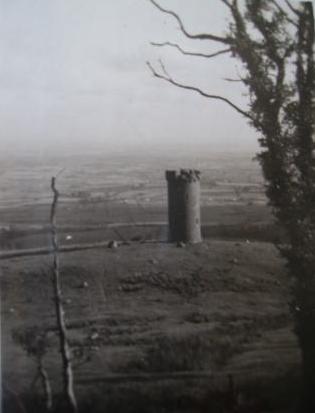
|
| Derrylahan House | This house was the home of the Mason family in the 19th century, occupied by James Mason in 1814 and by William Mason in the early 1850s. The buildings were valued at £10 and held from Peter D. La Touche. William Mason of Derrylahan owned 228 acres in the 1870s. A house and farm are still extant at the site. | |
| Longford | The Ordnance Survey Name Books refer to Robert Lloyd as the proprietor of Longford House in the 1840s and it was occupied by him and held from Thomas Prince Lloyd at the time of Griffith's Valuation when the house was valued at £16. A mansion house in the townland of Longford valued at £34+ was occupied by James Lloyd in 1906. A building is still located at this site. | |
| Mountfrisco | Mount-fresco was occupied by Thomas Lloyd in 1814 and by Horatio Lloyd in 1837 and in the early 1850s. The house was then valued at £10 and held in fee. This house is no longer extant. | |
| Loran Park | The seat of the Roe family in the 19th century, occupied by George Roe in 1837 and in the early 1850s, when the house was valued at £25.10 shillings and held from Henry Minchin. The residence of Ellen Robinson in the mid 1870s. A house and farm are still extant at the site. | |
| Whiteville | Leet records Mr Stephen Ryan as the resident of White-ville, Moneygall, in 1814. The Ordnance Survey Name Books refer to Whiteville as the residence of Robert White. Benjamin White was the occupier at the time of Griffith's Valuation. He held the property in fee and the buildings were valued at £13+. This house marked on the first edition Ordnance Survey map was replaced by a later house known as Knockanroger House and located slightly to the north of the original structure. A house is still extant at the site. | |
| Dangansallagh | Lewis records J. Lewis as resident at Dangan Lodge in 1837 and Griffith's Valuation records James Middleton holding the lodge valued at £10+ and 266 acres in fee. It is now a ruin. | |
| Dromard | The home of the Lidwill family, occupied by George Lidwill in 1814 and by Fred Lidwill in 1837 and in the early 1850s. The house was valued at £11 and held from George Goold. In the early 1940s the Irish Tourist Association surveyor described Dromard as a "very pretty building, set amidst well kept grounds and pleasure gardens". The owner was Colonel Robert Lidwell. Dromard House, Templemore, on 253 acres was advertised for sale in ''The Farmers Journal'' (6 Nov 2004) and sold for over 4 million euro in 2006 see http://www.independent.ie/national-news/yesterdays-auction-results-73225.html | |
| Ash Park | Ash Park or Park was the home of the Butler family in the 18th and 19th centuries. Occupied by James Butler in 1814 and 1837 and by Captain James Butler at the time of Griffith's Valuation. The buildings were valued at £35+ and held in fee. This house no longer exists. | |
| Skehanagh | George Lloyd was living in a house valued at £16 at Skehanagh North in the mid 19th century.The Ordnance Survey Name Books note "Skehana" as the residence of George Richard Lloyd in 1840. In the 1870s Horatio M. Lloyd of Skehana, Templemore owned 182 acres in county Tipperary. Catherine Lloyd was resident in 1906. This house burnt down and the present building on the same site dates from the early 20th century. |

|
| Killoskehane | This house was the seat of the Willington family. In 1837 Lewis wrote that Killoskehane Castle "includes part of the ancient castle in the modern mansion". The property was held by John Willington in fee at the time of Griffith's Valuation when the buildings were valued at £29+. Edward D. Martin was the occupier of Killoskehane in 1906 and William Costigan in the 1940s. The building is still extant and occupied. |

|
| Lisduff | The Smiths were resident at Lisduffe from the early 18th century when Jeremiah Lalor married the daughter of Samuel Smith of Lisduffe. From this couple descend the Lalors of Long Orchard. Samuel Smyth was the occupant of Lisduff in 1814 and William Smith in 1837. Griffith's Valuation records John Minchin as resident. The buildings were then valued at £33 and held from Admiral Darby. This house is still a residence. |
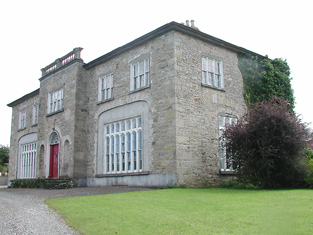
|
| Lloydsborough | In 1786 Wilson mentions that Lloydsborough was the seat of Mr. Carden. This house was the seat of the Lloyd family in the 19th century. In 1814 Henry Lloyd was resident and in 1837 John Lloyd was the occupant. Griffith's Valuation records John as holder of the property in fee and the buildings were valued at £44+. Lloydsborough was still in the possession of a branch of the Lloyd family in the early 20th century. Still extant and occupied, Lloydsborough was offered for sale in 2014. |

|
| Cranagh | Located beside a castle of the same name this house was occupied by John Lalor in 1814. Lewis records the property belonging to J. Lloyd but occupied by the Reverend M.N. Thompson. At the time of Griffith's Valuation Cranagh was in use as an Auxiliary Poor House and was valued at £25+. The Irish Tourist Association surveyor refers to a 4 storey house built at Crannagh in 1768 by the Lloyd family. The owner in the early 1940s was J. Cullen. This house is no longer in existence. | |
| Castleleiny | A house occupied by John Lloyd and his wife Debby Ann in the early part of the 19th century. Henry Jesse Lloyd son of the Reverend George Lloyd of Castle Iny and his wife Anne Hely entered the King's Inns in 1840. By the mid 19th century William Healy was the occupant holding the house valued at £12+ from the Earl of Orkney. | |
| Long Orchard | The Lalors were resident at Long Orchard from the mid 18th century. A relative, Edmund Dogherty, was the occupier in 1814. In 1837 Lewis records Richard Lalor Sheil as the proprietor. The Ordnance Survey Name Books in 1840 refer to the house as the residence of the local clergyman, Mr. Thomson. At the time of Griffith's Valuation he held the property from Richard Lalor Shiel when it was valued at £11. The Power Lalor family were still resident at Long Orchard in the early 20th century. Mrs Stella Power Lalor was the occupant in the early 1940s but the grounds and gardens had gone "wild" (Irish Tourist Association Survey).This house is now demolished. | |
| Honeymount | Honeymount was occupied by John Evans in 1814 and by Captain Lloyd in the early 1850s, when it was valued at £11.10 shillings and held from Leonard Williams. Robert Lloyd is recorded as the tenant in the sale notice of 1856. Honeymount, part of the estate of the Mahons of Co Clare, was advertised for sale in July 1871. A house is still extant at the site. In 2014 it was offered for sale. |

|
| Killough (Templemore) | Cottage type house built 1880. In 1906 Richard J. Lloyd is recorded as the occupier of a mansion house valued at £27+ in the townland of Killough. |
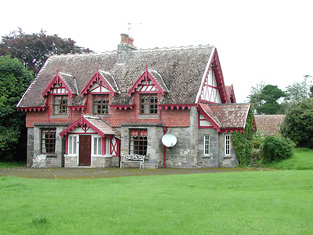
|
| Ballinlonty | Lewis records M. Fogarty as resident in 1837. In 1840 it is described by the Ordnance Survey Name Books as "a genleman's house" though the resident's name is not recorded. The house, valued at £9.10 shilling was held by Frederick J. Fegan in fee at the time of Griffith's Valuation. This house is no longer occupied. | |
| Sorrellhill | James Bennett was resident at Sorrel-hill, Templemore in 1814. This house is marked on the first edition Ordnance Survey map but looks larger in size on later maps. At the time of Griffith's Valuation, valued at £16.10 and held by Dudley Byrne from Philip Gowan. This house is still extant. | |
| Crawford's Lodge | In 1840 the Ordnance Survey Name Books refer to Crawford's Lodge as the residence of W. Crawford. At the time of Griffith's Valuation, the townland was held in fee by William Crawford when the house was valued at £6+. It is not labelled on the later 25-inch map of the 1890s though a house still exists at the site. |

